Introduction
The aim of the paper is to present tourism as an essential branch of the Czech economy and to point out the improving level of current tourism, where the vital indicator is not only the position of the Czech Republic in the European context but also the confrontation with the Czech tourism in continuity with important historical milestones reflected in the character of the specifics of Czech tourism.
As the history showed us, we can trace a growing increase in journeys to countries such as France, England, Germany, and Italy, which had attracted with, besides the desire for exploring the surrounding world, also the possibility of self-improvement and self-realization already in the 12th century. It is “the growth of education as a realization of the need for knowledge”, which, together with “the need to renew the connection with the nature in order to reproduce the workforce” and “to renew and establish contact with people”, represents “the immediate causes of modern tourism” (Jakubíková, 2009, p. 21). If we look at the current situation despite the considerable time-lapse, the latest EUROSTAT data (January 22, 2019) available confirm a similar situation, as Italy, France, Germany, the United Kingdom, and Spain were among the most popular destinations in 2018, which accounted for 67% of the number of overnight stays throughout the European Union (EU). Individual shares of these countries exceeded the threshold of 10%, i.e., in absolute terms, in Italy and France, the number of nights spent exceeded 200 million, with a year-on-year increase of 1% in both countries. The most significant year-on-year increase in this TOP 5 belonged to Germany (+4.3%). For Spain, Great Britain (GB), we can observe a year-on-year decrease in overnight stays by 1.6, or 6.3%, which are joined by Luxembourg (-5.2%), Ireland (-4.0%), Finland (-0.6%), Greece (-0.4%), and Cyprus (-0.01%), which represents 12.7 million nights in the accumulated depreciation of these countries. In most European countries, however, the interest in accommodation was higher than in the previous year, including the Czech Republic (+4.3%), which showed an above-average increase in the number of nights spent by guests in accommodation facilities (STATISTIKA&MY, 2019).
As projected by the UNWTO (United Nations World Tourism Organization), by 2020 the number of tourists in the world should be 1.56 billion people. The forecast framed by the Czech Tourism subsequently states that by 2020 the Czech Republic should become one of the most significant world destinations with 44 million tourists a year (data based on the 1995 methodology, recalculated according to the current statistics methodology corresponds to approximately 15 million tourists) (Jarolímková, 2018). The primary trend of the development of Czech tourism is its quantitative increase in all monitored fundamental performance indicators, namely in all three basic types of tourism – domestic, outbound, and arrival.
Theoretical Framework
The Czech Republic and the History of Tourism
Although the history of tourism in the Czech Republic could be divided primarily into the period before and after the Velvet Revolution, we have found a number of significant milestones since 1888. In that year, the Czech Tourist Club had been founded with the significant objective to promote the Slavic idea as well as with its efforts to enhance tourism and its promotion beyond the borders in the form of organizing trips and lectures, which were the first direct promotional means and inspired the general interest in traveling. The club also published its magazine (the Tourists’ Magazine – one of the oldest journals about tourism in Europe), tourist guides and maps, as well as by building the necessary infrastructure for tourism, and so on (Vystoupil et al., 2011). The year 1918 was another critical milestone (the establishment of an independent Czechoslovak state) with the establishment of the Czechoslovak Tourists Club in relation to the setting of the program for the period of 1918-38, where besides activities directly related to tourism such as improving the level of hospitality of establishments, building recreational facilities, etc., publishing and promotional and printing (maps, journals and magazines, etc.) activities were in the foreground with the aim to support youth travel. The year 1919 was a significant step in the construction of the statistical base of tourism with the establishment of the State Statistical Office, based on the first relevant statistical data in the field of tourism. The first information source about accommodation facilities in Czechoslovakia traces back to 1921, when the Ministry of Industry and Trade initiated the formation of the State Directory of Hotels in Czechoslovakia 3 in which one could find detailed information on available recreational facilities (e.g., addresses, transport possibilities and reachability, owners or lessors, number of rooms and beds, prices for accommodation).
The change in socio-political conditions after 1948 also aimed at changing the conditions of tourism development reflecting in its current forms and types, which meant the end of “free-minded” business activities (nationalization of property, abolition of the Czechoslovak Tourists Club, and such), and in the development of socialist-oriented tourism (closing of the “western borders”, forced orientation towards the neighboring socialist countries, mass character, etc.), reflected in the decline of domestic and foreign tourism mainly due to political reasons – persisting until the 1980s.
The democratization of the political situation after the “Velvet Revolution” (1989) reflected in the fundamental changes in the organization of tourism, with both the “small-scale” (from 1991 to about 2006) and especially the “large-scale” privatization (from 1993 to about 2000) in the Czech Republic; further it was opening of borders, which fundamentally changed the geopolitical situation in the foreign passive and active tourism, but specifically the modern democratic management replacing the directive management and organization of tourism development at central, regional or local level in continuity with new tools (e.g., concepts and programs of tourism development, the allocation of funds after accession of the Czech Republic to the EU, the establishment of travel agencies and information centers, teaching tourism at universities and secondary schools, especially secondary management and marketing ones, etc.), which opened the door for the return of the Czech Republic to other European states (Šauer et al., 2015).
Present Situation
The characteristics of tourism from 2004 to the present include the expansion of infrastructures, increasing capacity and spectrum of services offered, as well as increasing competition between providers of tourism and between destinations. The most important types of Czech tourism include recreational tourism, primarily the forms of an active holiday (e.g., hiking, cycling, winter sports), and sightseeing tourism. Traditionally, spa and congress tourism are of a significant place here, as well as the development of both urban and rural tourism. The increasing demand for specific topics such as film, travel or food tourism, dark tourism, event tourism, adventure tourism, volunteer tourism, wedding tourism, honeymoon tourism, LGBT tourism, and others become a typical feature (Kotíková, 2013).
Indicators of Tourism Statistics
The essence of obtaining the data is the methodological definition of the observed indicators in relation to the data collection method. The official European statistics are produced in the framework of the European Statistical System, while the duty of statistical authorities (SO) of the EU countries, which is the regular monitoring of information on tourism, is regulated by the EU Regulation 692/2011 (on the European Statistics on Tourism). In most EU countries, residents’ trips abroad are monitored through sample surveys in households, while foreigners’ arrivals are mainly based on information found in collective accommodation establishments. Statistical calculations and extrapolations influence the final data. According to the EU, when speaking about trips only those made by persons over 15 years of age, regardless of the type of accommodation, are compulsorily monitored; for arrivals, only so-called collective accommodation establishments must be monitored without any regard to age (i.e., including children). Only when following all the rules, will each statistical source have its value and quality, and can be adequately analytically usable. The SO is, therefore, obliged to ascertain the transmission of harmonized data on tourism at prescribed time intervals, structure, and details.
The specific features of the Czech environment include monthly surveys in households in the form of a Tourism Sample Survey (TSS) with the extrapolation of data to the total population with an indicator of the structure and number of trips in the classification for domestic and outbound tourism. The enterprise survey monitors the offers of accommodation infrastructure and its utility in the form of regular corporate reporting, in which the statistical unit is every individual accommodation facility – the offered capacity (number of units, rooms, beds) in continuity with the attendance (number of guests and overnight stays by source countries, utilization rate, and so on) (CZSO, 2016).
Methodology
Problem Formulation
As shown by the previous lines, the Czech Republic has set on another part of its route concerning tourism – and as the start of the lengthy and uneasy journey for the Czech Republic has proved, the country will not do without the realization of marketing activities on the existing competitive field. The information, its quality and form of transfer represent the moving force for the development of tourism. Even though tourism in the European Union stands on a relatively significant position, the contemporary situation of domestic as well as outbound tourism in the Czech Republic represent one of its significant aspects, together with the quantity and quality of accommodation establishments, and so on.
Problem Solution
The aim of the study is, based on the secondary data stemming from the statistical indicators, to find answers to questions of what the current level of tourism in the Czech Republic is, whether the specifics of the Czech environment can be reflected in the characteristics of the current state of tourism, etc. reflecting, e.g., in the choice of short-term or long-term stays, or changes in the reference of accommodation facilities, organized or unorganized forms of travel, etc. As well as the extent to which possible changes in the field of outbound or inbound tourism reflect. For the analysis of tourism, a timeline in the period 2012-2018 was deliberately chosen, reflecting the gradual, with a few exceptions, fluctuating demand growth in domestic and foreign tourism in the Czech Republic, which followed an apparent decline in some segments of the sector during the 2008-2010 crisis, fading in 2011.
Results and Interpretation
Indicators of Domestic and Outbound Tourism in the Czech Republic
According to the following data, with some exceptions, we may observe that in years 2012-18 there was a fluent growth in tourism, being it in, for instance, the indicator in continuity with short trips (ST): 1-3 overnight stays (Table 1a.-3a.), or in long trips (LT): 4 and more overnight stays (Table 1b.-3b.) (CZSO-ST, 2019; CZSO-LT, 2019).
Table 1a: Short trips (1-3 overnight stays) of the Czech residents in the CR and abroad (thousands) – number and purpose
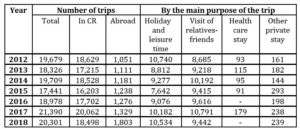 (Source: CZSO-ST, 2019)
(Source: CZSO-ST, 2019)
Table 1b: Long trips (4 and more overnight stays) of the Czech residents in the CR and abroad (thousands) – number and purpose
 (Source: CZSO-LT, 2019)
(Source: CZSO-LT, 2019)
The data comparison (Table 1a × 1b.) unequivocally confirmed an increased interest in ST, especially in the Czech Republic, although we can see a gradual increase in international tourism, while the most significant increase was seen in both forms (ST + LT) especially in 2017. In the case of long stays, however, there has been an inclination towards the preference of international tourism over domestic stays in the Czech Republic over the last three years. The greatest agreement was seen in the purpose of the trip, primarily when it comes to recreation, vacation or leisure, which is also significantly higher than the short stay at one’s relatives and acquaintances while on short trips, compared to the naturally increasing number of health stays. The agreement could also be seen in the preference of ST + LT from the position of gender, where women stand in front of men in the whole monitored period (in thousands): 2012a.: f/10,341; m/9.339 + 2012b.: f/6,351; m/5,376 × 2018a.: f/10,604; m/9,697 + 2018b.: f/6,799; m/6,076 (CZSO-ST, 2019; CZSO-LT, 2019).
Table 2a: Short trips (1-3 overnight stays) of the Czech residents in the CR and abroad (thousands) – the type of accommodation
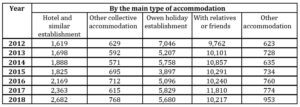 (Source: CZSO-ST, 2019)
(Source: CZSO-ST, 2019)
Table 2b: Long trips (4 and more overnight stays) of the Czech residents in the CR and abroad (thousands) – type of accommodation
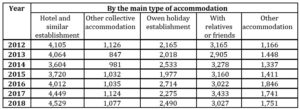 (Source: CZSO-LT, 2019)
(Source: CZSO-LT, 2019)
As the previous data showed (Table 2a.× 2b.), although we can encounter a slight decrease in the number of STs (for example, weekend stays), in the Czech Republic a very popular stay in one’s own recreational facilities is still a fundamental form of accommodation regarding the most preferred type of stay at one’s relatives and acquaintances. The significantly increasing interest in hotel accommodation or similar accommodation shows as a beneficial aspect in ST (2012a.: 1,619 × 2018a.: 2,682), which belongs to the preferred form primarily in LT (2012b.: 4,105 × 2018b.: 4,529).
The use of the primary means of transport is also related to the length of the trip, as evidenced by the increasing preference of the passenger car ST: 2012/15,933 × 2018/ 17,252 × LT: 2012/7,709 × 2018b/9,032 – with the corresponding prevailing number of STs realized within the Czech Republic. A change of travel can be seen in a significant increase in the number of STs carried out by air transport (2012/30 thousand × 2018/198 thousand), while a decrease in bus travel (2012/1,904 × 2018/1,170), the position of train travel remained almost unchanged (2012/1,640 × 2018/1,620). Air transport is the primary form of transport also for LT (2012/1,664 × 2018/1,620), although the growth is not so enormous. Reductions can be seen in the implementation of LT either by bus (2012/1,399 × 2018/1,135) or by train (2012/886 thousand × 2018/600 thousand) (CZSO-ST, 2019; CZSO-LT, 2019).
Table 3a: Short trips (1-3 overnight stays) of Czech residents in CR and abroad (thousands) – the way of the trip organization
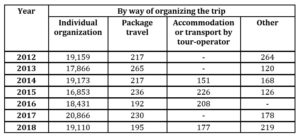 (Source: CZSO-ST, 2019)
(Source: CZSO-ST, 2019)
Table 3b: Long trips (4 and more overnight stays) of Czech residents in CR and abroad (thousands) – length and the way of the trip organization
 (Source: CZSO-LT, 2019)
(Source: CZSO-LT, 2019)
Also from the point of view of organizing the trip (Table 3a.× 2b.), there is a visible consensus in the increasing interest in individual travel arrangements for both STs and LTs, while the logical outcome of the trips is the use of LT travel agencies within the holiday organization, while we may see that in years 2012-2018 the position of travel agencies weakened its position, and currently has strengthened its position again.
However, the number of guests and overnight stays in collective accommodation establishments by country is one of the major findings of tourism development. As the following figures show (Table 4), we can see that compared to 2012, the number of guests increased by about 6 million, i.e., by 40%, while in the number of residents (domestic visitors, i.e., those whose resident country is the same as a visited country – e.g., a citizen of the particular country and foreign nationals living in that particular country) and non-residents (foreign visitors whose country of residence is different from the country visited, e.g., a citizen of a particular country permanently living abroad (CZSO – Concepts and definitions, 2019) almost match.
Table 4: Guests and overnight stays in collective accommodation establishments by countries
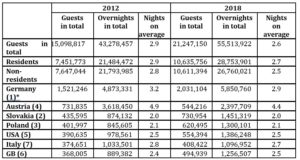 ( )* ordering in 2018
( )* ordering in 2018
(Source: CZSO, 2019 – Period 2012, Period 2018)
From the perspective of the most crucial source countries in 2012, the change in the number of foreign visitors in 2018 is evident. Germany has retained its leading position with an immense increase in the number of guests, although we see a decreasing tendency in the average number of overnight stays (nights). Russia is the only country where there has been a significant reduction in visitors. In 2018 there was another change compared to 2012, as there was a significant increase in visitors from China (2012/152,866 × 2018/617,935) and South Korea also came in the top position (2018/415,156), where the number of visitors within Czech tourism since 2015 (119,999), although compared to 2017 we can see a slight decrease (415,555) (CZSO, 2019 – Period 2017).
Summing up the previous result values in a general characteristic of Czech tourism for consumer behavior, it is clear that the essential specifics include the predominance of domestic tourism over outbound tourism, while short stays do over long-term stays in the continuity with the nature of unorganized tourism. And even though the choice of rising accommodation standards is increasing with the reflection of rising living standards, we can still see the pre-revolutionary character of tourism in continuity with limited travel opportunities, with regular weekend stays at weekend places and houses having the priority in domestic tourism. From the perspective of foreign tourist destinations in continuity with long journeys, Croatia is one of the most popular ones among Czechs, and Slovakia is again in the forefront.
The uneven distribution of demand (geographically) is a characteristic feature of the incoming tourism CR, where the capital city of Prague and the world-famous spa Karlovy Vary and Mariánské Lázně are primarily in the forefront of foreign tourists’ interest. And while we can still consider Germany as the most important source market, we can see changes reflected in the faster growth in arrivals from the Eastern territories, be it South Korea or China.
Conclusion
How to conclude? By saying that tourism has become a global phenomenon today. There is no one who would not be associated with it, whether in the role of a participant, local resident in tourism centers, or an employee. As mentioned in the introduction to this paper, 2018 was a very successful year for entrepreneurs in accommodation services. As the presented indicators show, the number of visitors to collective accommodation establishments has been continuously increasing in the Czech Republic for several years, as evidenced by the fact that in 2018 more than 21 million guests stayed in the Czech Republic and the number of overnight stays exceeded 55 million nights. In relative terms, the number of arrivals increased in the year-on-year perspective by 6.2% and the number of overnight stays was 4.3% higher than in the previous year 2017. The year-on-year dynamics were higher for residents (+6.6%) compared to 2017 than for non-residents (+1.9%). A slight decrease in the average length may be a problem for the future when the guest stayed on average for 2.6 nights, and respectively they stayed at the place of accommodation for 3.6 days, which proves long-term gradual shortening of stays (2000/4.1 nights) (CZSO, 2019 – Period 2017).
As for foreign guests, the Czech Republic can still be considered an attractive destination, which is confirmed by the number of arrivals and overnight stays of foreign visitors, which were the highest in the past year. As the data (Table 4) presented, the highest number of guests who visited the Czech Republic came from Germany, which was 3.5% more than in 2017, in Slovakia which was second the figure increased by 7.2%, and for the third Poland, the increased number of visits and overnight stays even by 7.8%. We must again refer to the arrivals mentioned earlier from China with a 26.1% year-on-year increase, together with the opposite statistics of accommodation, with decreases in arrivals from Russia (-0.7%), South Korea (-1.1%), France (-1.1%) or Israel (-1.5%) (CZSO, 2019 – Period 2018).
The fact that tourism is an important economic activity at the national and regional level is also evidenced by the latest published data (February 28, 2019), which in 2017 accounted for 2.9% of the Czech Republic’s gross domestic product (CZK 149 billion). It employed 238,800 persons, which was by 2.4% more in the year-on-year. Employees made up 82% and self-employed persons doing business in the field by 18%. The total amount of expenditures on tourism reached 292 billion crowns. It is an aggregate demand indicator of all visitors who spent their holidays in the Czech Republic. Inbound tourism made up of foreign visitors amounted to more than 56%, i.e., 164 9 billion crowns. The remaining 44% of the funds (127 6 billion crowns) were generated by domestic visitors through domestic tourism (CZSO – 29.02.2019).
As the brief insight into the development of tourism in the Czech Republic has shown, despite the success of 2018, new ways have to be sought, whether it is the need to attract the attention of residents and non-residents not only to visit individual regions of the Czech Republic but also to achieve them to stay as long as possible. However, every destination cannot make the optimal use of its potential for tourism development. At present, gaining a significant position in tourism cannot do without strategic marketing, i.e., reconciling the strengths of a business company with the groups of customers whom it can serve (Kotler, 2007), which entails much-needed communication. Information technology brings new opportunities in communication with visitors, while potential visitors change the way they process and organize information. The critical areas of success of destination marketing are thus reaching as many potential visitors, ensuring long-term maximization of visitor value, and interacting on social networks and facilitating the creation of user-generated content (Handbook, 2008). The aim is then to ensure optimal satisfaction of the diverse needs of tourism of people of all social strata in tourism accommodation facilities in a calm environment and concerning the needs of the local population.
(adsbygoogle = window.adsbygoogle || []).push({});
References
- Cestovní ruch přinesl ekonomice 292 miliard korun. The Czech Statistical Office (CZSO) 2019. [Online], [Retrieved August 8, 2019], https://www.czso.cz/csu/czso/cestovni-ruch-prinesl-ekonomice-292-miliard-korun.
- Cestovní ruch v zemích Evropské unie. In: STATISTIKA&MY. Měsíčník Českého statistického úřadu. 02/2019. [Online], [Retrieved Juni 19, 2019], https://www.statistikaamy.cz/2019/02/cestovni-ruch-v-zemich-evropske-unie/.
- Cestovní ruch – základní pojmy a definice. ČSÚ 2019. [Online], [Retrieved Juni 18, 2019], https://www.czso.cz/documents/10180/20557193/921108m.pdf/b6571837-6a2e-4138-912c-59da6de43de4?version=1.0
- Handbook on E-marketing for Tourism Destinations. (2008), UNWTO Elibrary.
- Jakubíková, D. (2009), Marketing v cestovním ruchu, Praha: Grada Publishing, a.s.
- Jarolímková, L. (2018), Cestovní ruch České republiky, KCR VŠE Praha. [Online], [Retrieved May 16, 2019],https://kcr.vse.cz/wp-content/uploads/page/319/Cestovn%C3%AD-ruch-%C4%8Cesk%C3%A9-republiky.pdf
- Kotíková, H. (2013), Nové trendy v nabídce cestovního ruchu, Praha: Grada Publishing, a.s.
- Kotler, P. et al. (2007), Moderní marketing. Praha: Grada.
- The Czech Statistical Office (CZSO) 2016. [Online], [Retrieved Juni 18, 2019], https://www.czso.cz/csu/czso/methodology_time_series_tourism.
- Occupancy in collective tourist accommodation establishments by country. Period: 2012. Territory: Czech Republic. The Czech Statistical Office (CZSO) 2019. [Online], [Retrieved May 28, 2019], https://vdb.czso.cz/vdbvo2/faces/en/index.jsf.
- Occupancy in collective tourist accommodation establishments by country. Period: 2018. Territory: Czech Republic. The Czech Statistical Office (CZSO) 2019. [Online], [Retrieved May 28, 2019], https://vdb.czso.cz/vdbvo2/faces/en/index.jsf.
- Occupancy in collective tourist accommodation establishments by country. Period: 2017. Territory: Czech Republic. The Czech Statistical Office (CZSO) 2019. [Online], [Retrieved May 28, 2019], https://vdb.czso.cz/vdbvo2/faces/en/index.jsf.
- Short trips (1-3 overnights) of Czech residents in the Czech Republic and abroad. The Czech Statistical Office (CZSO) 2019. [Online], [Retrieved Juni 26, 2019], https://www.czso.cz/csu/czso/cru_ts.
- Long trips (4 and more overnights) of Czech residents in the Czech Rebublic and abroad. The Czech Statistical Office (CZSO) 2019. [Online], [Retrieved Juni 26, 2019], https://www.czso.cz/csu/czso/cru_ts.
- Šauer, M., Vystoupil, J., Holešinská, A. et al.: (2015), Cestovní ruch (učební text). Brno: MU.
- Vystoupil, J., Šauer, M. et al. (2011), Geografie cestovního ruchu České republiky. Plzeň: Aleš Čeněk, s.r.o.









